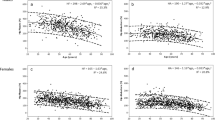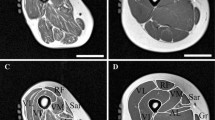Abstract
Secular changes and intra-individual differences in body shape and size can confound cross-sectional studies of muscle ageing. Normalising muscle mass to height squared is often suggested as a solution for this. We hypothesised that normalisation of muscle volume to femur volume may be a better way of determining the extent of muscle lost with ageing (sarcopenia). Thigh and femur muscle volumes were measured from serial magnetic resonance imaging sections in 20 recreationally active young men (mean age 22.4 years), 25 older men (72.3 years), 18 young women (22.1 years) and 28 older women (72.0 years). There were no age-related differences in femur volume. The relationship between thigh muscle volume and femur volume (R 2 = 0.76; exponent of 1.12; P < 0.01) was stronger than that with height (R 2 = 0.49; exponent of 3.86; P < 0.01) in young participants. For young subjects, the mean muscle/bone ratios were 16.0 and 14.6 for men and women, respectively. For older men and women, the mean ratios were 11.6 and 11.5, respectively. The Z score for the thigh muscle/bone volume ratio relative to young subjects was −2.2 ± 0.7 for older men and −1.4 ± 0.8 for older women. The extent of sarcopenia judged by the muscle/bone ratio was approximately twice that determined when normalising to height squared. These data suggest that the muscle/bone ratio captures the intra-individual loss of muscle mass during ageing, and that the age-related loss of muscle mass may be underestimated when normalised to height squared. The quadriceps seems relatively more affected by ageing than other thigh muscles.





Similar content being viewed by others
References
Ahlborg HG, Johnell O, Turner CH et al (2003) Bone loss and bone size after menopause. N Eng J Med 349:327–334
Allen MD, Mcmillan SJ, Klein CS et al (2011) Differential age-related changes in bone geometry between the humerus and the femur in healthy men. Aging Dis 2:1–8
Andersen JL (2003) Muscle fibre type adaptation in the elderly human muscle. Scand J Med Sci Sports 13:40–47
Baumgartner RN, Koehler KM, Gallagher D et al (1998) Epidemiology of sarcopenia among the elderly in New Mexico. Am J Epidemiol 147:755–763
Degens H (2012) Determinants of skeletal muscle hypertrophy and the attenuated hypertrophic response at old age. J Sports Med Doping Stud S1:003. doi:10.4172/2161-0673.S1-003
Degens H, Korhonen M (2012) Factors contributing to the variability in muscle ageing. Maturitas 73(3):197–201
Delmonico MJ, Harris TB, Visser M et al (2009) Longitudinal study of muscle strength, quality, and adipose tissue infiltration. Am J Clin Nutr 90:1579–1585
Dufour AB, Hannan MT, Murabito JM et al (2013) Sarcopenia definitions considering body size and fat mass are associated with mobility limitations: the Framingham study. J Gerontol A Biol Sci Med Sci 68(2):168–174
Estrada M, Kleppinger A, Judge JO et al (2007) Functional impact of relative versus absolute sarcopenia in healthy older women. J Am Geriatr Soc 55:1712–1719
Feik SA, Thomas CD, Clement JG (1996) Age trends in remodeling of the femoral midshaft differ between the sexes. J Orthop Res 14:590–597
Frontera WR, Hughes VA, Fielding RA et al (2000) Aging of skeletal muscle: a 12-yr longitudinal study. J Appl Physiol 88:1321–1326
Garn S, Rohmann C, Wagner B, Ascoli W (1967) Continuing bone growth throughout life: a general phenomenon. Am J Phys Anthropol 26(3):313–317
Garrett WE, Califf JC, Bassett FH (1984) Histochemical correlates of hamstring injuries. Am J Sports Med 12:98–103
Gillette-Guyonnet S, Nourhashémi F, Andrieu S (2003) Body composition in French women 75+ years of age: the EPIDOS study. Mech Ageing Dev 124:311–316
Hairi N, Cumming R, Naganathan V et al (2010) Loss of muscle strength, mass (sarcopenia), and quality (specific force) and its relationship with functional limitation and physical disability: the concord health and ageing in men project. J Am Geriatr Soc 58:2055–2062
Heijmans BT, Tobi EW, Stein AD et al (2008) Persistent epigenetic differences associated with prenatal exposure to famine in humans. Proc Natl Acad Sci USA 105:17046–17049
Iannuzzi-Sucich M, Prestwood KM, Kenny AM (2002) Prevalence of sarcopenia and predictors of skeletal muscle mass in healthy, older men and women. J Gerontol A Biol Sci Med Sci 57:M772–M777
Janssen I, Heymsfield S, Wang Z, Ross R (2000) Skeletal muscle mass and distribution in 468 men and women aged 18–88 yr. J Appl Physiol 89:81–88
Janssen I, Heymsfield SB, Ross R (2002) Low relative skeletal muscle mass (sarcopenia) in older persons is associated with functional impairment and physical disability. J Am Geriatr Soc 50:889–896
Jones DA, Round JM, Edwards RHT et al (1983) Size and composition of the calf and quadriceps muscles in Duchenne muscular dystrophy. A tomographic and histochemical study. J Neurol Sci 60:307–322
Kenny AM, Dawson L, Kleppinger A et al (2003) Prevalence of sarcopenia and predictors of skeletal muscle mass in nonobese women who are long-term users of estrogen-replacement therapy. J Gerontol A Biol Sci Med Sci 58:M436–M440
Lauretani F, Russo CR, Bandinelli S et al (2003) Age-associated changes in skeletal muscles and their effect on mobility: an operational diagnosis of sarcopenia. J Appl Physiol 95:1851–1860
Lissner L, Mehlig K, Sjöberg A et al (2013) Secular trends in weight, height and BMI in young Swedes: the “Grow up Gothenburg” studies. Acta Paediatr. doi:10.1111/apa.12087
Lumey LH, Stein AD, Kahn HS et al (2007) Cohort profile: the Dutch Hunger Winter families study. Int J Epidemiol 36:1196–1204
Maden-Wilkinson TM, Degens H, Jones DA, McPhee JS (2013) Comparison of MRI and DEXA to measure muscle size and age-related differential atrophy in individual thigh muscles. J Musculoskeletal Neuronal Interact 13(3) (in press)
McNeil CJ, Raymer GH, Doherty TJ et al (2009) Geometry of a weight-bearing and non-weight-bearing bone in the legs of young, old, and very old men. Calcif Tissue Int 85:22–30
McPhee J, Hogrel J, Maier A, Seppet E, Seynnes O, Sipilä S, Bottinelli R et al (2013) Physiological and functional evaluation of healthy young and older men and women: design of the European Myoage study. Biogerontology 14(3):325–337
Moayyeri A, Luben R (2008) Measured height loss predicts fractures in middle-aged and older men and women: the EPIC-Norfolk prospective population study. J Bone Miner Res 23:425–432
Morley JE, Baumgartner RN, Roubenoff R et al (2001) Sarcopenia. J Lab Clin Med 137:231–243
Morse CI, Degens H, Jones DA (2007) The validity of estimating quadriceps volume from single MRI cross-sections in young men. Eur J Appl Physiol 100:267–274
Prentice A, Jebb S (1995) Obesity in Britain: gluttony or sloth? BMJ 311:437–439
Riggs BL, Merton LJ, Robb RA et al (2004) Population-based study of age and sex differences in bone volumetric density, size, geometry, and structure at different skeletal sites. J Bone Miner Res 19:1945–1954
Rittweger J (2008) Ten years muscle–bone hypothesis: what have we learned so far? -Almost a Festschrift-. J Musculoskelet Neuronal Interact 8:174–178
Rittweger J, Beller G, Ehrig J, Jung C, Koch U, Ramolla J, Schmidt F et al (2000) Bone-muscle strength indices for the human lower leg. Bone 27(2):319–326
Rosenberg IH (1989) Summary comments. Am J Clin Nutr 50:1231–1233
Ruff C, Hayes W (1988) Sex differences in age-related remodeling of the femur and tibia. J Orthop Res 6:886–896
Rutherford OM, Jones DA (1992) The relationship of muscle and bone loss and activity levels with age in women. Age Ageing 21:286–293
Schiessl H, Frost H, Jee W (1998) Estrogen and bone-muscle strength and mass relationships. Bone 22(1):1–6
Schoenau E, Neu CM, Beck B et al (2002) Bone mineral content per muscle cross-sectional area as an index of the functional muscle-bone unit. J Bone Miner Res 17:1095–1101
Sorkin JD, Muller DC, Andres R (1999) Longitudinal change in height of men and women: implications for interpretation of the body mass index. Am J Epidemiol 150:969–977
Wilks DC, Winwood K, Gilliver SF, Kwiet A, Chatfield M, Michaelis I, Sun LW et al (2009) Bone mass and geometry of the tibia and the radius of master sprinters, middle and long distance runners, race-walkers and sedentary control participants: a pQCT study. Bone 45(1):91–97
Acknowledgments
JMcP was supported by Myoage EU FP7 223576.
Author information
Authors and Affiliations
Corresponding author
About this article
Cite this article
Maden-Wilkinson, T.M., McPhee, J.S., Rittweger, J. et al. Thigh muscle volume in relation to age, sex and femur volume. AGE 36, 383–393 (2014). https://doi.org/10.1007/s11357-013-9571-6
Received:
Accepted:
Published:
Issue Date:
DOI: https://doi.org/10.1007/s11357-013-9571-6




